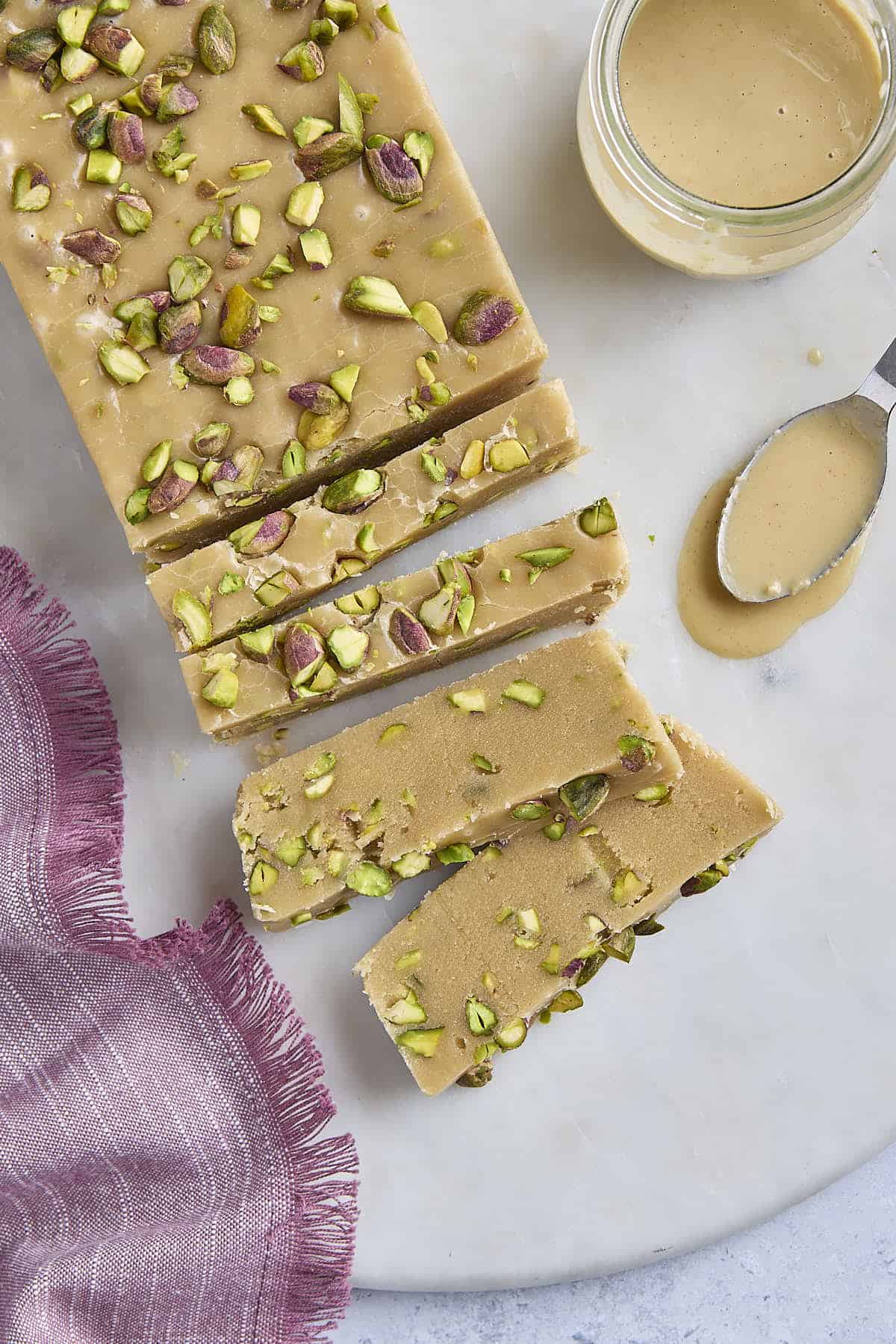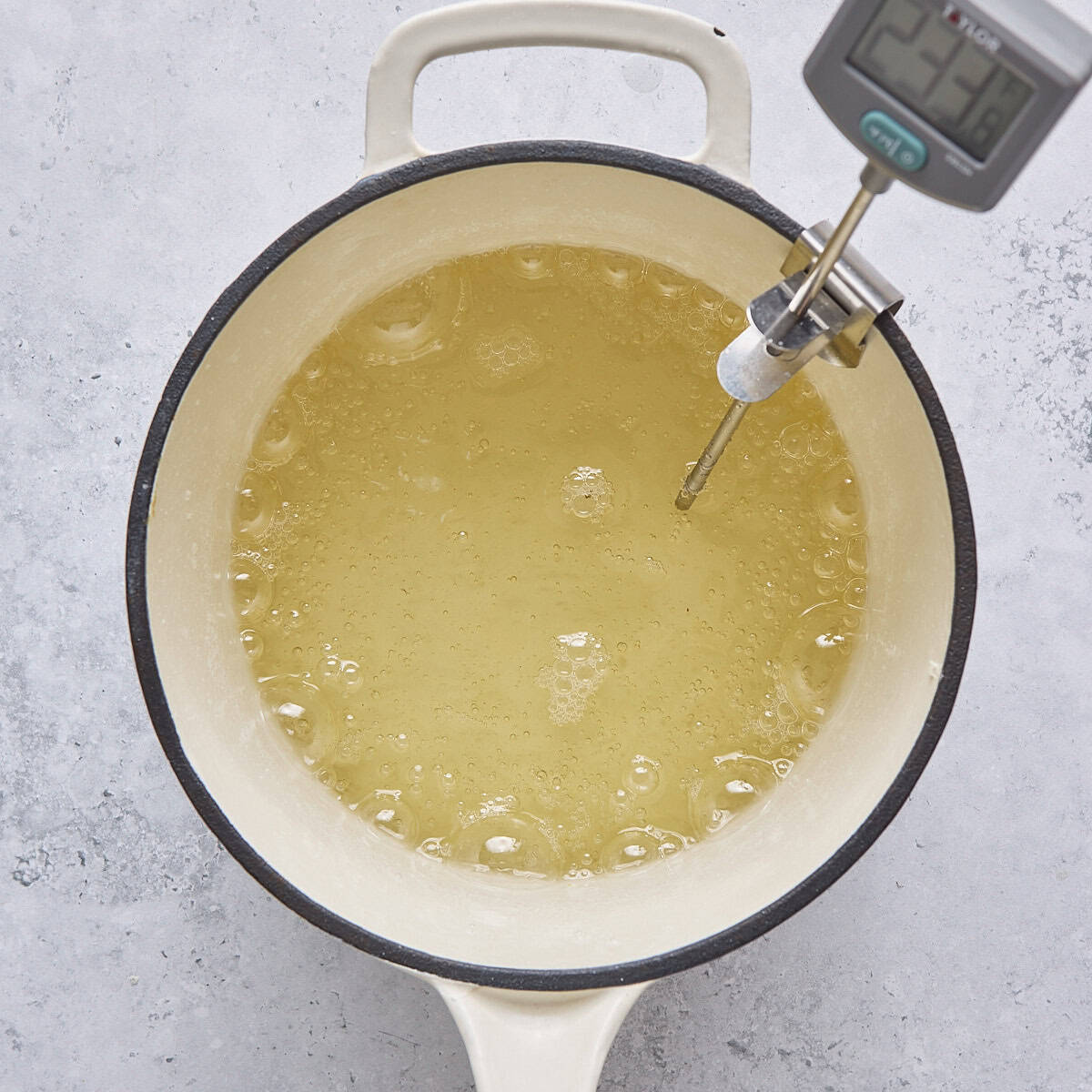Halva
Published Mar 26, 2025
Easy Halva recipe made on the stovetop with granulated sugar and water. Tahini is mixed in with a splash of rose water and pistachios.
This post may contain affiliate links. Please read our disclosure policy.

Jump to Section
Have You Tried Halva?

Halva is one of those foods that I grew up seeing in my pantry. My parents always had a tub of it and I would eat it from time to time, but I wasn’t its biggest fan. As I got older though I really started to appreciate the flavor more.
So, I asked my mom how to make it. She said she never learned how to (and neither did her siblings or mom) because it was so cheap to buy. Still, I didn’t love that the packaged ones had emulsifiers and citric acid added to them, so I set out to find a way to make homemade halva.
After much research, I found two methods for making halva from scratch: one with milk powder and powdered sugar and the other with sugar that’s cooked into a candy. I didn’t want to mess with milk powder so I started experimenting with the cooking temperatures of the sugar along with the ratio of the tahini to sugar. After a few tries and with the help of my kitchen assistant who’s a pastry chef, we found the optimal temperature for cooking the sugar to give us the consistency of fudge.

What is Halva?
The Arabic word for halva is halwa or halawa, which means “sweet confection”.
Made with tahini, it has a fudge-like consistency, but is still flaky and crumbly. I love to eat halva on its own, but it’s also delicious mixed into things like tahini brownies, blondies, cookies, fruit tarts, and quick breads.
Halva Ingredients

- Tahini: Use a runny tahini, which will be easier to mix with the rest of the ingredients.
- Rose water: Like you might expect, this is very floral-tasting! While I think it’s worth seeking out, if you can’t find it, you could try substituting almond or vanilla extract.
- Sugar: Make sure to use granulated, white sugar!
- Pistachios: You can buy pre-shelled pistachios, but make sure they’re unsalted. Salted pistachio might make the halva too salty!
Halva Variations
- Chocolate: Instead of the pistachios, stir in ½ cup of chopped chocolate and top the halva with more chopped chocolate. I think dark chocolate would be great here!
- Cardamom: Add ½ teaspoon cardamom to the tahini mixture.
- Lemon-rosemary: Mix 1 tablespoon lemon zest and 1 teaspoon chopped, fresh rosemary into the tahini mixture.
- Cherry: Mix in ¼ cup chopped pistachios and ¼ chopped dried cherries.
- Toasted coconut: Instead of the pistachios, mix ½ cup of toasted coconut into the halva. Top the halva with more toasted coconut.
How to Make Halva








My Best Halva Tips
- Pay attention to the sugar syrup temperature. When you’re cooking the sugar with water, you need to use a candy thermometer! The different stages of candy making refer to the increasing concentration of sugar as the water evaporates and every stage results in a different texture. The stage we want is at 235°F, which is called the “soft ball”—perfect for a fudgy consistency that won’t quickly crumble.
- Line the loaf pan. Lining the loaf pan with parchment paper will make it easy to lift the halva up and out after it cools and makes it easier to slice.
- Add the tahini mixture slowly. This will allow to evenly mix it into the sugar syrup without needing to over mix things! It also prevents the tahini and hot sugar from sputtering up and out at you.
- Don’t rush the cooling process. For the right texture, you want to cool the halva at room temperature and in the fridge.

Recipe Help & FAQs
If it’s a couple of degrees, you’re probably okay, but if it’s much higher, you’ll need to start the process over! Making candy is super specific and you need to stick 235°F for the right halva consistency. It’s also why I recommend using a candy thermometer!
If it’s still soft and gooey after chilling, the sugar syrup might not have reached the right temp before mixing in the tahini. That 235°F mark is really important anything under that and it may not firm up fully.
It’s usually because the sugar syrup was cooked too long or got too hot. You want it to reach 235°F not higher. If it goes past that, it starts to firm up too much and can make the halva dry and brittle instead of soft and sliceable.
It’s super versatile. You can slice it and enjoy it just as-is (which is how I usually eat it), but you can also crumble it over yogurt, tuck it into a dessert plate with fruit and nuts, or even serve it with tea or coffee as a little sweet bite.

More Middle Eastern Dessert Recipes:
- Almond Crusted Cardamom Cake
- Ka’ak il Eid anise cookies
- Layali Lubnan semolina pudding
- Maamoul walnut and date
- Namoura semolina cake
- Atayef
- Homemade Knafeh
- Sfouf turmeric cake
If you try this Halva recipe or any other recipe on Feel Good Foodie, then don’t forget to rate the recipe and leave a comment below! It helps others who are thinking of making the recipe. I would love to hear about your experience making it. And if you snapped some shots, share it on Instagram so we can repost on Stories!

Halva Recipe
Ingredients
- 1 ½ cups tahini
- 1 teaspoon rose water
- Pinch salt
- 1 ½ cups sugar
- ¾ cup water
- ½ cup unsalted raw pistachios roughly chopped
Instructions
- Line a loaf pan with parchment paper with a little overhang for easier lifting. Set aside.
- In a small bowl, combine tahini, rose water, and salt. Set aside.
- In a small saucepan over medium-high heat, add the sugar and slowly pour the water to cover the sugar. Cook, until mixture reaches 235°F on a candy thermometer, 10-15 minutes.
- Carefully and slowly pour the tahini mixture into the syrup mixture and stir until fully incorporated and glossy. It will thicken as you stir. Fold in the pistachios.
- Pour into the prepared loaf pan. Sprinkle more pistachios on top and smooth the top. Allow it to cool at room temperature for 30 minutes. Then cover with plastic wrap and refrigerate until set, about 2 hours. Slice into 8 or 10 slices and serve.
Notes
Nutrition
Nutrition information provided is an estimate. It will vary based on cooking method and specific ingredients used.





